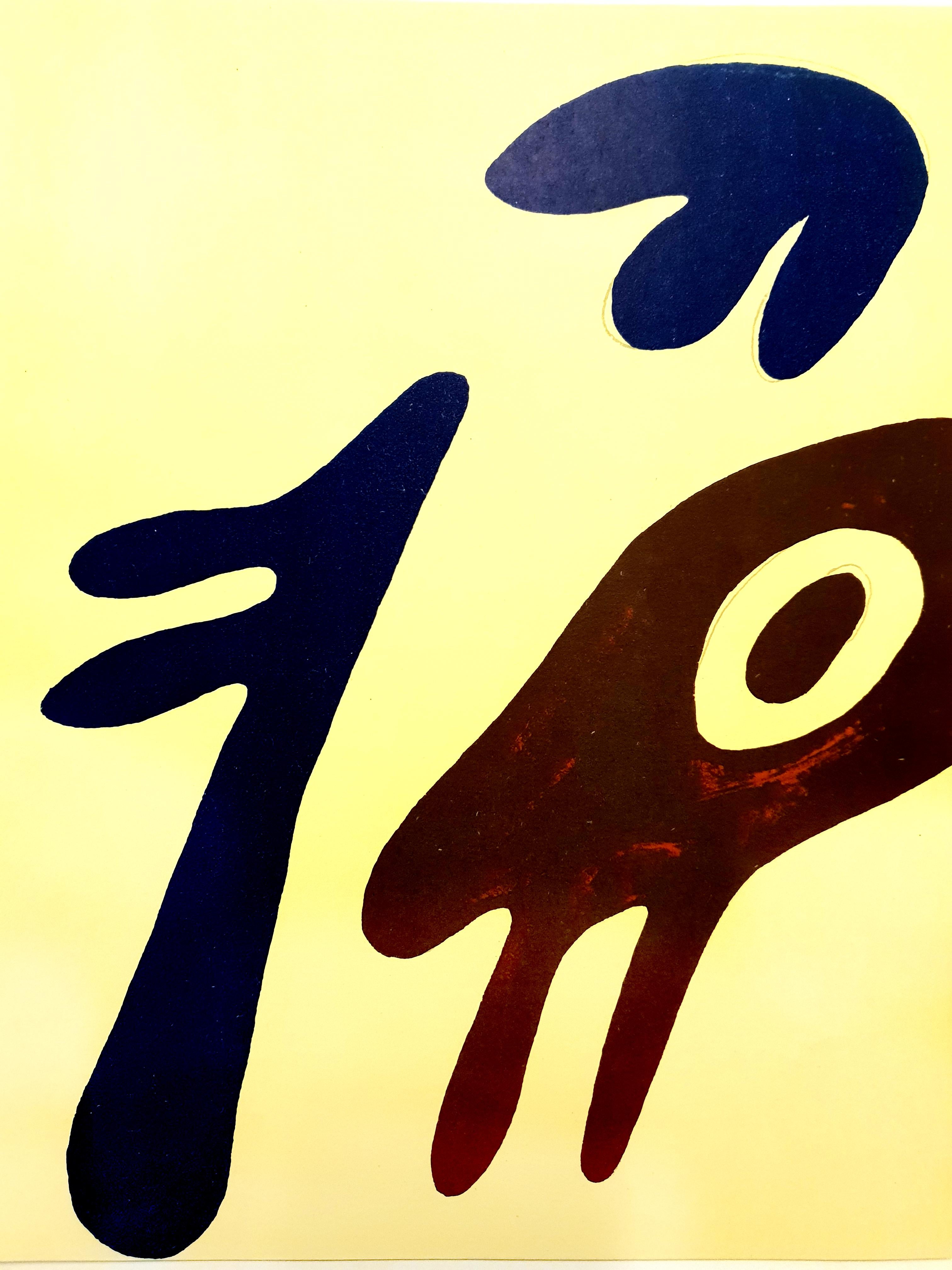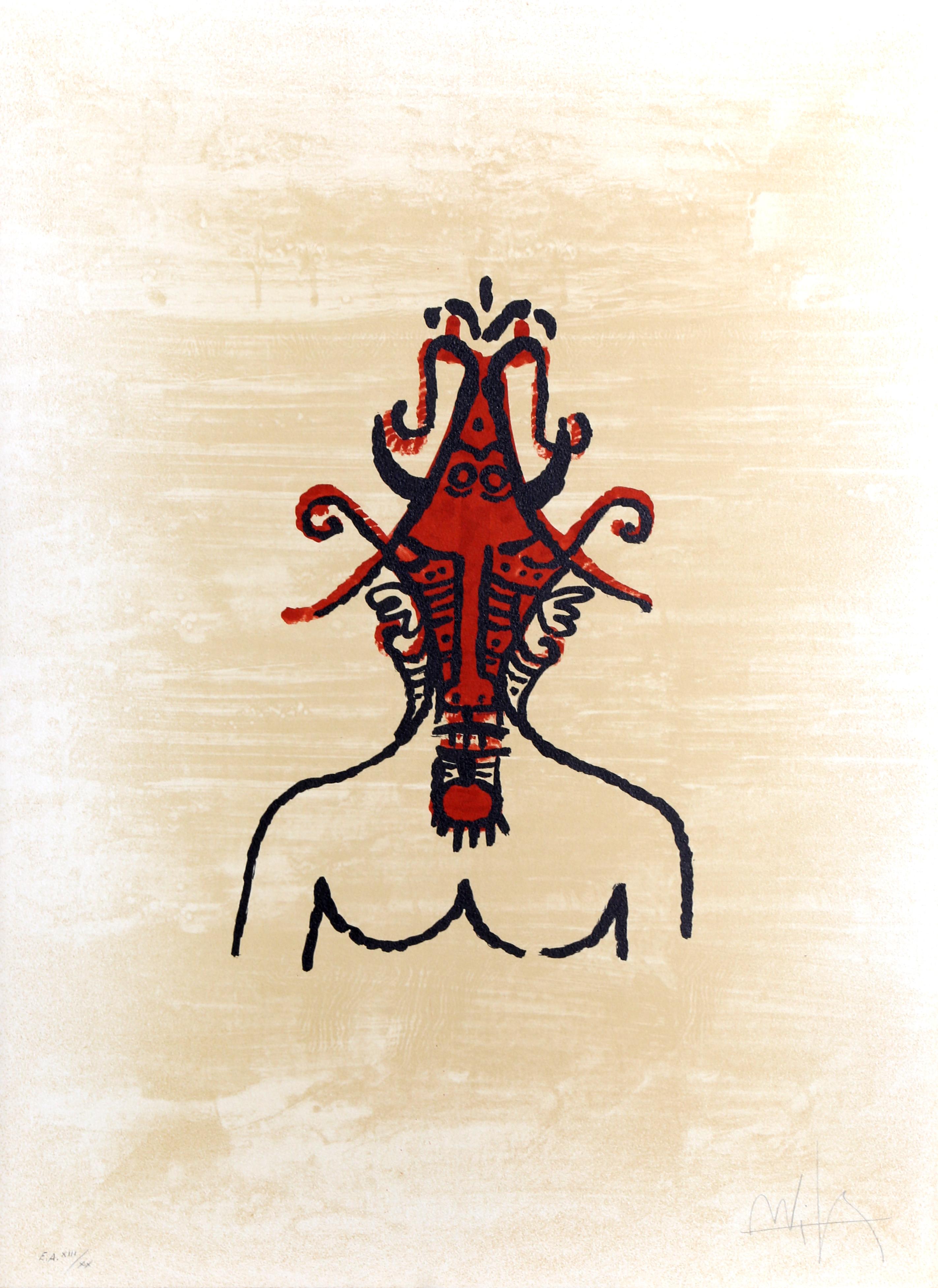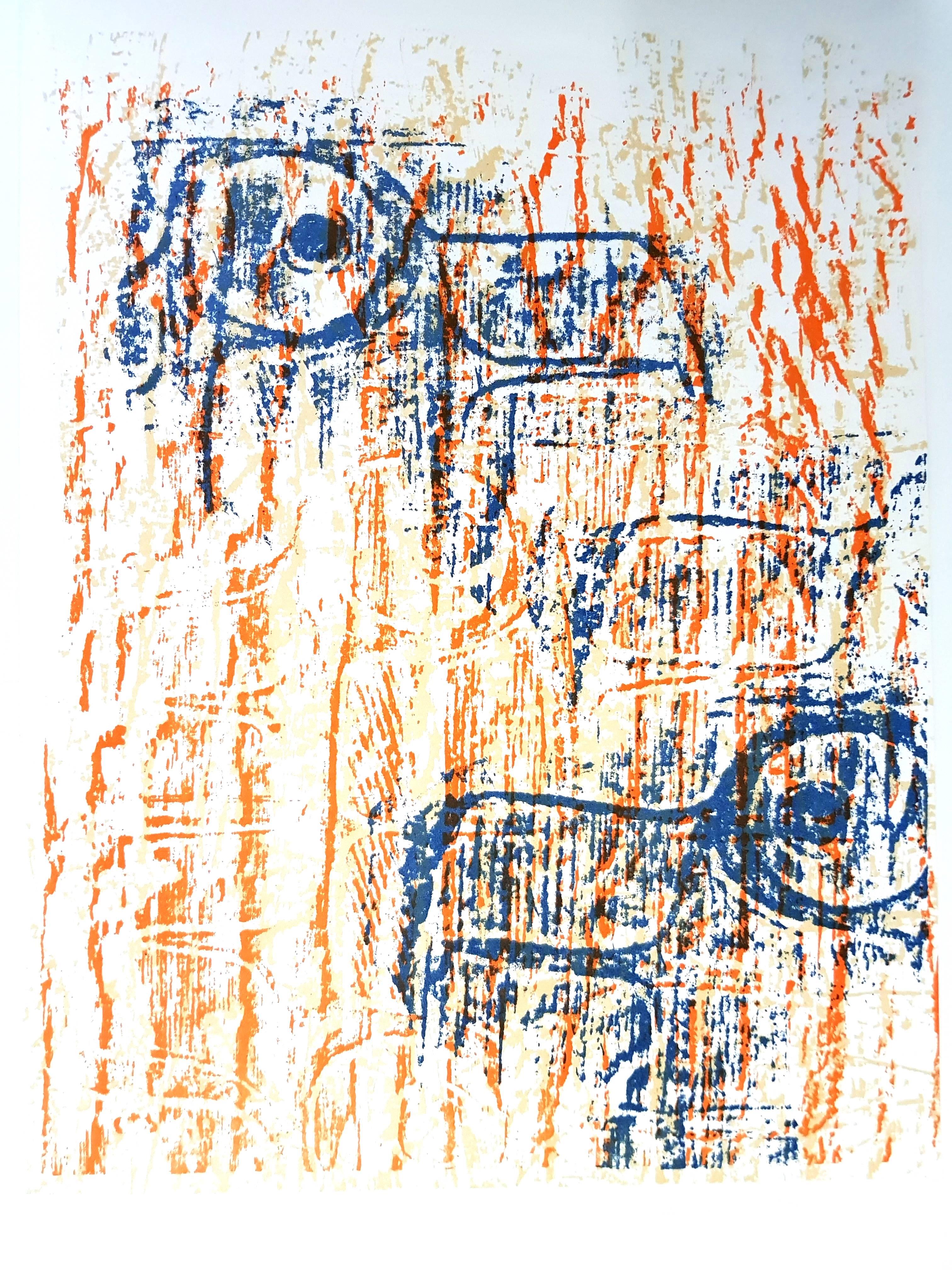Leonor FiniPsuedo sonnet1972
1972
About the Item
- Creator:Leonor Fini (1908 - 1996, French)
- Creation Year:1972
- Dimensions:Height: 23.5 in (59.69 cm)Width: 20 in (50.8 cm)
- More Editions & Sizes:Edition of 190Price: $6,240
- Medium:
- Movement & Style:
- Period:
- Condition:
- Gallery Location:Columbia, MO
- Reference Number:1stDibs: LU1976214047052
Leonor Fini
Leonor Fini was the life of the party during the French Surrealist movement. A socialite with connections to some of the movement's biggest names, Fini was also an astoundingly gifted artist in her own right. In fact, many consider her to be the most fiercely independent female artist of the 20th century. A theatrical personality, Fini created prints, paintings and drawings that are widely revered for their sensuous qualities and raw energy.
Fini's life started off in a dramatic fashion, which was perhaps a portent of things to come. She was born in Buenos Aires, Argentina in 1907, but her parents separated soon after and her mother took her away to Trieste, Italy. Due to her father's attempts to kidnap her, Fini was often dressed as a boy throughout her childhood.
Fini was surrounded by artistic women in Trieste, and she naturally developed a love for art as well. By the time she was 17, she had become familiar with Renaissance art and Mannerist painting and was exhibiting her own portraits. In 1931, at just 24 years of age, Fini moved to Paris and became acquainted with influential artists Giorgio de Chirico and Carlos Carrà. She also met and started a romantic relationship with Surrealist pioneer Max Ernst, who introduced her to others in the movement.
Though she had no formal art education, Fini proved herself to be both technically masterful and creatively exceptional. Her work and her flamboyant personality attracted the attention of many of the 20th century's most celebrated artists and thinkers, including Salvador Dalí, Jean Cocteau, Albert Camus and Jean Genet, just to name a very few. She exhibited her work in many Parisian art galleries, including the gallery of Christian Dior before the fashion icon became a designer.
In the 1950s, Fini continued painting while immersing herself in other artistic and dramatic endeavors, including theater costume and mask design. She also designed posters for the Paris Opera and wardrobes for movies.
Fini continued living and painting in Paris for the rest of her life. She died in 1996.
On 1stDibs, find original Leonor Fini prints, paintings and drawings.
- ShippingRetrieving quote...Ships From: Columbia, MO
- Return PolicyThis item cannot be returned.
- PoutBy Leonor FiniLocated in Columbia, MOLeonor Fini was born in Argentina in 1907 but travelled and lived in Europe with her mother from a young age. By 1931, she was in Paris, in the full swing of the Surrealist movement....Category
Mid-20th Century Surrealist Figurative Prints
MaterialsEtching
- HeaddressBy Leonor FiniLocated in Columbia, MOLeonor Fini was born in Argentina in 1907 but travelled and lived in Europe with her mother from a young age. By 1931, she was in Paris, in the full swing of the Surrealist movement....Category
Mid-20th Century Surrealist Figurative Prints
MaterialsEtching
- Nymph CrownsBy Leonor FiniLocated in Columbia, MOLeonor Fini was born in Argentina in 1907 but travelled and lived in Europe with her mother from a young age. By 1931, she was in Paris, in the full swing of the Surrealist movement....Category
Mid-20th Century Surrealist Figurative Prints
MaterialsEtching
- YawnBy Leonor FiniLocated in Columbia, MOLeonor Fini was born in Argentina in 1907 but travelled and lived in Europe with her mother from a young age. By 1931, she was in Paris, in the full swing of the Surrealist movement....Category
Mid-20th Century Surrealist Figurative Prints
MaterialsEtching
- Heads and Figures Variations (A)By Leonor FiniLocated in Columbia, MOLeonor Fini was born in Argentina in 1907 but travelled and lived in Europe with her mother from a young age. By 1931, she was in Paris, in the full swing of the Surrealist movement....Category
Mid-20th Century Surrealist Animal Prints
MaterialsEtching
- Robed FigureBy Leonor FiniLocated in Columbia, MOLeonor Fini was born in Argentina in 1907 but travelled and lived in Europe with her mother from a young age. By 1931, she was in Paris, in the full swing of the Surrealist movement....Category
Mid-20th Century Surrealist Figurative Prints
MaterialsEtching
- Marc Chagall - Couple With a Goat - Original LithographBy Marc ChagallLocated in Collonge Bellerive, Geneve, CHMarc Chagall Original Lithograph Title: Couple With a Goat 1970 Dimensions: 32 x 24 cm From the art revue XXè siècle Reference: Mourlot #608 Unsigned and unumbered as issuedCategory
Mid-20th Century Surrealist Figurative Prints
MaterialsLithograph
- Le Picador, Surrealist Lithography by Salvador DaliBy Salvador DalíLocated in Long Island City, NYA picador rides in on a horse, lance in hand, to enrage a bull we cannot see. The horse theme was frequently used by Dali throughout his career. The horse is seen as a symbol of beau...Category
1970s Surrealist Animal Prints
MaterialsLithograph
- Jean Arp - Original LithographBy Jean ArpLocated in Collonge Bellerive, Geneve, CHJean Arp - Original Lithograph 1962 Dimensions: 32 x 24 cm From the art review XXe siècle Unsigned and unumbered as issuedCategory
1960s Surrealist Animal Prints
MaterialsLithograph
- El Ultimo Viaje Del Buque Fantasma, Lithograph by Wifredo LamBy Wifredo LamLocated in Long Island City, NYEl Ultimo Viaje Del Buque Fantasma by Wifredo Lam, Cuban (1902–1982) Year: 1976 Lithograph, signed and numbered in pencil Edition of EA XIII/XX Size: 30 x 21.75 in. (76.2 x 55.25 cm)Category
1970s Surrealist Figurative Prints
MaterialsLithograph
- Max Ernst - Birds - Original LithographBy Max ErnstLocated in Collonge Bellerive, Geneve, CHMax Ernst - Birds - Original Lithograph Birds, 1964 (BNF, 63) Dimensions: 32 x 24 cm Revue Art de France ax Ernst was born in Bruhl, a place near Cologne, in Germany. He was raised in a strict Catholic family, and both of his parents were disciplinarians who were dedicated to training their children into God-fearing and talented individuals. Although his father was deaf, Ernst learned so much from him, particularly when it comes to painting. In fact, much of his early years were lived under the inspiration of his father who was also a teacher. He was the one who introduced painting to Ernst at an early age. In 1914, Ernst attended the University of Bonn where he studied philosophy. However, he eventually dropped out of school because he was more interested in the arts. He claimed that his primary sources of interest included anything that had something to do with painting. Moreover, he became fascinated with psychology, among other subjects in school. Primarily, Ernst's love for painting was the main reason why he became deeply interested with this craft and decided to pursue it later on in his life. During his early years, he became familiar with the works of some of the greatest artists of all time including Claude Monet, Paul Cezanne and Vincent van Gogh. He was also drawn to themes such as fantasy and dream imagery, which were among the common subjects of the works of Giorgio de Chirico. During World War I, Ernst was forced to join the German Army, and he became a part of the artillery division that exposed him greatly to the drama of warfare. A soldier in the War, Ernst emerged deeply traumatized and highly critical of western culture. These charged sentiments directly fed into his vision of the modern world as irrational, an idea that became the basis of his artwork. Ernst's artistic vision, along with his humor and verve come through strongly in his Dada and Surrealists works; Ernst was a pioneer of both movements. It was Ernst's memories of the war and his childhood that helps him create absurd, yet interesting scenes in his artworks. Soon, he took his passion for the arts seriously when he returned to Germany after the war. With Jean Arp, a poet and artist, Ernst formed a group for artists in Cologne. He also developed a close relationship with fellow artists in Paris who propagated Avant-Garde artworks. In 1919, Ernst started creating some of his first collages, where he made use of various materials including illustrated catalogs and some manuals that produced a somewhat futuristic image. His unique masterpieces allowed Ernst to create his very own world of dreams and fantasy, which eventually helped heal his personal issues and trauma. In addition to painting and creating collages, Ernst also edited some journals. He also made a few sculptures that were rather queer in appearance. In 1920s, influenced by the writings of psychologist Sigmund Freud, the literary, intellectual, and artistic movement called Surrealism sought a revolution against the constraints of the rational mind; and by extension, they saw the rules of a society as oppressive. Surrealism also embraces a Marxist ideology that demands an orthodox approach to history as a product of the material interaction of collective interests, and many renown Surrealism artists later on became 20th century Counterculture symbols such as Marxist Che Guevara. In 1922 Ernst moved to Paris, where the surrealists were gathering around Andre Breton. In 1923 Ernst finished Men Shall Know Nothing of This, known as the first Surrealist painting. Ernst was one of the first artists who apply The Interpretation of Dreams by Freud to investigate his deep psyche in order to explore the source of his own creativity. While turning inwards unto himself, Ernst was also tapping into the universal unconscious with its common dream imagery. Despite his strange styles, Ernst gained quite a reputation that earned him some followers throughout his life. He even helped shape the trend of American art during the mid-century, thanks to his brilliant and extraordinary ideas that were unlike those of other artists during his time. Ernst also became friends with Peggy Guggenheim, which inspired him to develop close ties with the abstract expressionists. When Ernst lived in Sedona, he became deeply fascinated with the Southwest Native American navajo art. In fact, the technique used in this artwork inspired him and paved the way for him to create paintings that depicted this style. Thus, Ernst became a main figure of this art technique, including the rituals and spiritual traditions included in this form of art. Pollock, aside from the other younger generations of abstract expressionists, was also inspired by sand painting of the Southwest...Category
1960s Surrealist Animal Prints
MaterialsLithograph
- Max Ernst - Birds - Original LithographBy Max ErnstLocated in Collonge Bellerive, Geneve, CHMax Ernst - Birds - Original Lithograph Birds, 1964 Dimensions: 32 x 24 cm From the art review XXe siècle Unsigned and unumbered as issuedCategory
1960s Surrealist Animal Prints
MaterialsLithograph






